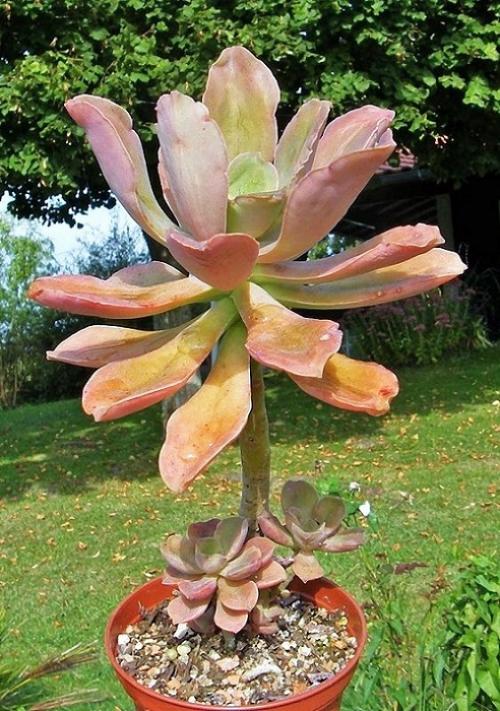BICOLOR var. BICOLOR (engl./ fr.)
First Description (in Latin) as Sedum bicolor by Humboldt & Bonpland in Nova Genera et Species Plantarum 6: 45. 1823.
Synonyms :
Sedum bicolor Humb. & Bonpl. (1823)
Echeveria bracteolata Link & al. (1842) / Cotyledon bracteolata (Link & al.) Baker (1869)
Echeveria venezuelensis Rose (1930)
Series Nudae
Type : Humboldt & Bonpland s.n.
Etymology : Referring to the two-coloured flowers.
Distribution : Venezuela, northern Colombia.
Description (according to Charles Uhl, 1992*) :
Stems to 50 cm tall or occasionally more, often with a low branch or two.
Leaves in loose terminal rosettes, always green, often shiny and never more than slightly glaucous, oblanceolate to spatulate, up to 7 cm long and 2.5 cm wide, and usually with a shallow longitudinal groove or concavity above.
Inflorescences : Bracts also green, up to 25 mm long and 8 mm wide, smaller upward, pedicels short, 3 - 4 mm long, and seated directly in the axils of their subtending bracts, with two rather long (8 - 10 mm) green bracteoles.
Flowers : Sepals nearly equal, ca. 8 mm long, green and widely spreading at anthesis, corolla about 10 mm long with tips that spread 7 to 9 mm apart, mostly yellow but flushed outside with variable amounts of red.
*Uhl, C.H.: Notes on Echeveria in Venezuela - I: E. bicolor in Cactus and Succulent Journal (US) 64(3): 122-123. 1992.
Note :
1. According to Charles Uhl, the diversity of echeverias in Venezuela is considerable. Apart from E. bicolor several more species may occur there but as long as no substantial research has been undertaken, the situation remains unsolved.
2. Sedum bicolor, E. bracteolata and E. venezuelensis have all been collected in the same region (near Caracas), that's why the names are synonymous, the oldest having priority.
3. E. bicolor is widespread in Venezuela and in the West also extending into Colombia. Typical E. bicolor is from near Caracas and appears to occur primarily at relatively lower elevations (ca. 1'000 to 1'500 m).
4. Uhl does not agree with Walther's concept of E. bicolor because Walther includes also E. subspicata in the synonymy of E. bicolor, a species only known from dried material, collected in Colombia at a height of 5'800 m asl, while E. bicolor is from much lower elevations of 1'000 - 1'500 m asl.
5. Moreover the plant Walther used for his description of E. bicolor has almost certainly been E. montana - it had 22 pairs of chromosomes, a number not found in any of the Venezuelan echeverias, however correct for E. montana.
> Walther's description is to be ignored.
6. Two variant forms from the states of Mérida and Tachira, called Form #1 and Form #2, are included in E. bicolor (Uhl in Cactus and Succulent Journal US 65(2): 81-87. 1993).
7. For differences between E. bicolor and E. recurvata see Note for E. recurvata.
8. The description in Pilbeam, The genus Echeveria, p. 58, 2008, deviates partly from the above description, and also the photo Fig. 35 showing a distinctly glaucous plant does not agree with Uhl's concept of E. bicolor - "always green, often shiny and never more than slightly glaucous". The flower photo Fig. 36 definitely is not E. bicolor, the flowers lacking the characteristic subtending bracts as well as the two bracteoles on the pedicels - features clearly visible on Myron Kimnach's scan on the following page (Fig. 37).
9. The ISI 91-42 Echeveria bicolor is misidentified, it is E. recurvata.
Link to the French translation.

Photo Emmanuelle Aubé